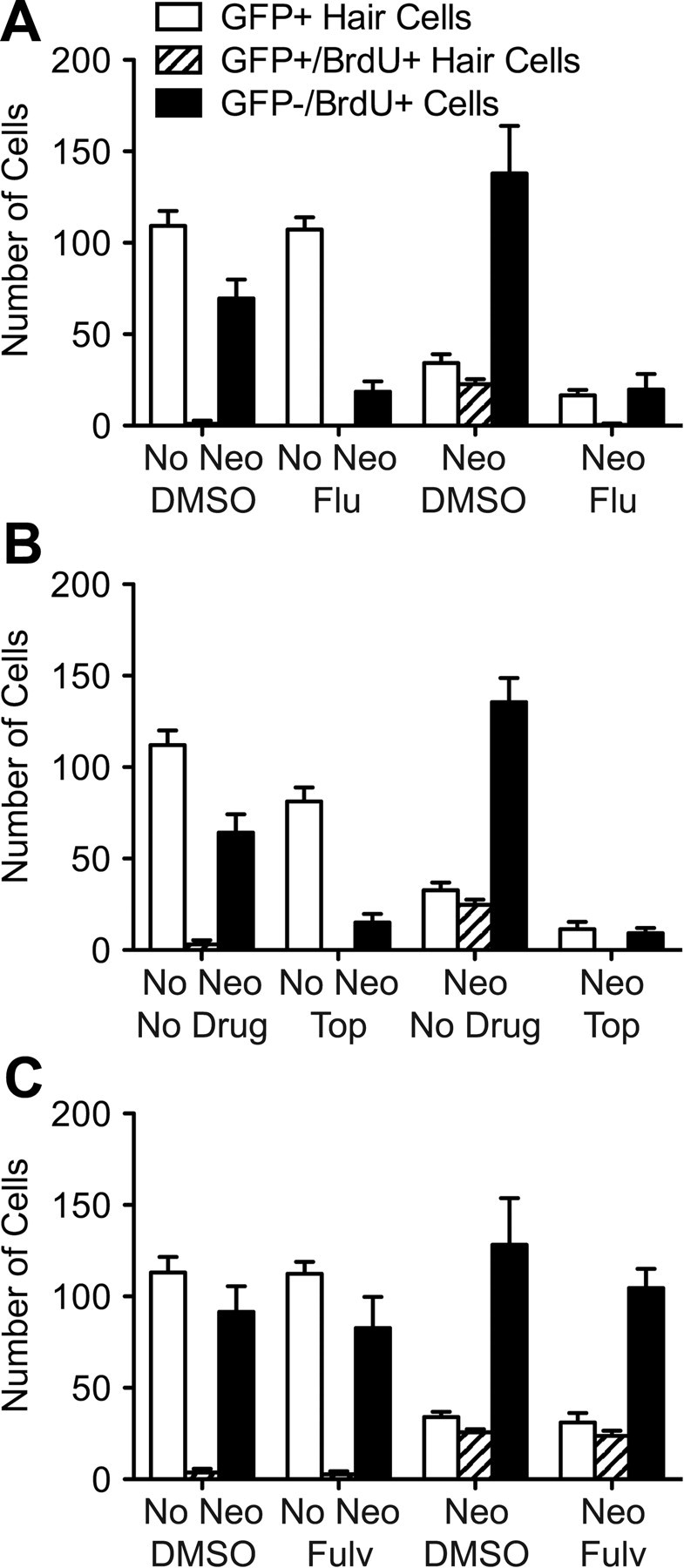Figure 8.

Inhibitor compounds prevent support cell division. Fish were treated with 400 μm neomycin (or mock-treated) for 1 h, and then exposed to 5 μm BrdU plus inhibitor (5 μm flubendazole,10 μm topotecan, or 5 μm fulvestrant) for 24 h. At 24 h after neomycin treatment, animals were fixed and immunolabeled for hair cells and BrdU. A, Fish mock-treated (No Neo) and then incubated in DMSO have virtually no GFP+/BrdU+ hair cells, as is observed in fish mock-treated and exposed to flubendazole. The number of GFP−/BrdU+ cells is greatly diminished between these groups suggesting that flubendazole is suppressing cell division in the absence of hair cell death. In fish treated with neomycin (Neo) and DMSO, significant regeneration is observed after 24 h (open bar), most of which are co-labeled with BrdU (striped bar). GFP−/BrdU+ cell counts are substantially elevated (black bar), due to the fact that support cell division is occurring at a rapid pace to replace lost hair cells. In fish treated with neomycin and subsequently with flubendazole (Flu), significantly fewer hair cells are produced, and of those hair cells visible, almost none are labeled with BrdU. The number of BrdU-labeled support cells is dramatically reduced as well. B, An almost identical pattern of GFP and BrdU labeling is observed in samples treated with topotecan (Top) as seen above. GFP−/BrdU+ labeling is dramatically reduced in fish treated with topotecan, regardless of neomycin treatment, indicating that the drug is suppressing all cell divisions. After neomycin treatment and subsequent incubation in topotecan for 24 h, there are significantly fewer hair cells regenerated, and of those few hair cells, none are co-labeled with BrdU. In mock-treated fish (No Neo), there is a noticeable decrease in the number of hair cells in fish exposed to topotecan, consistent with the idea that topotecan also kills mature hair cells. C, Mock-treated fish (No Neo) that were incubated in 5 μm fulvestrant (Fulv) display an essentially identical pattern of GFP and BrdU labeling to mock-treated fish incubated in DMSO. There is no significant GFP+ hair cell or GFP−/BrdU+ support cell loss between these groups. In fish treated with neomycin and later incubated in fulvestrant, GFP+ hair cell and GFP+/BrdU+ hair cell counts are similar to controls. However, GFP−/BrdU+ cell counts in fulvestrant-treated groups were slightly diminished (p < 0.01) compared with DMSO controls. For each fish, seven neuromasts were examined (n = 10 fish/group). Error bars indicate ±1 SD.
